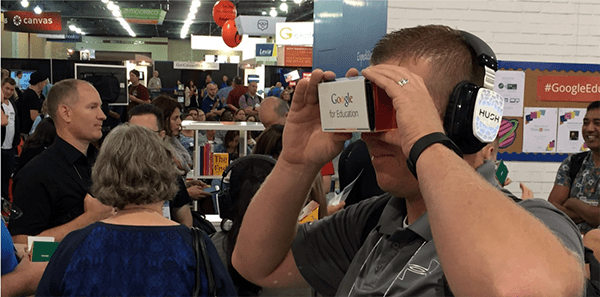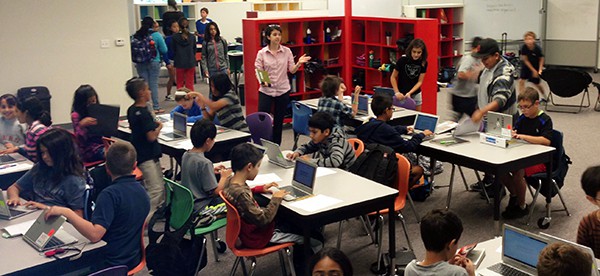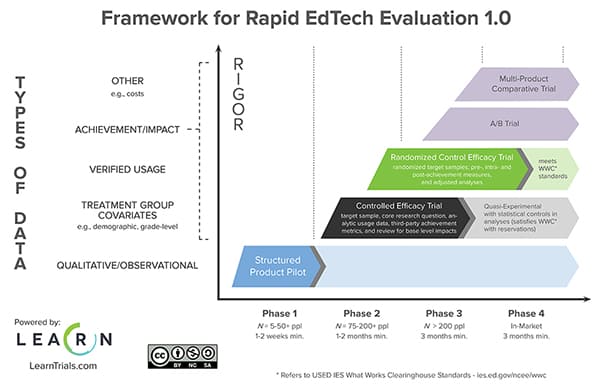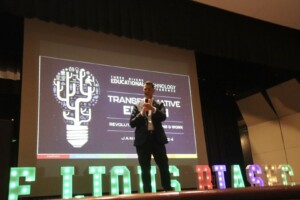Exponential Technology: Everything is Closer Than it Appears

“Objects in mirror are closer than they appear.” That familiar warning applies to the windshield not the rearview mirror when it comes to technology. We’re living on an exponential curve but our brains make linear projections. When it comes to new technology, almost everything is closer than it appears.
Moore’s Law of computer memory power doubling every two years has proven true for 50 years. More computing power, explains Ray Kurzweil, has been powering exponential technology change. He predicted 15 years ago that we’d experience the historical equivalent of 20,000 years of progress in this century as a result of accelerating technology change.
Eight New Givens
A conspiracy of exponential technologies have reshaped customer expectations and design requirements. Eight new tech givens include:
- Mobile: key to frequency
- Video: key to engagement
- Social: key to virality and stickiness
- Responsive: five screen sizes and more to come
- Cloud: requires anywhere integrations
- Quantified: unlocking my digital data
- My space, my stream: content to people, not people to content.
- Big data: key to matching people and things
Put those design principles to work on an intuitive platform and you can unleash powerful network benefits–think Facebook, Linkedin, and Twitter. Just around the corner is widespread use of immersive technology particularly augmented and virtual reality.
There are eight consequential learning inevitabilities that are reshaping education, professional learning and personal growth. Eight new EdTech givens include:
- Broader aims: competitive skills are the baseline; innovation mindset is the difference
- Blended: anytime anywhere augments face-to-face learning
- Modular: content, funding, and environments becoming modular and student-centered
- Personalized: learner profiles and modular content power personal pathways
- Competency-based: show what you know, earn a badge, progress on mastery
- Communities: relationship powered collaboration and growth
- Learner experience: more authentic, engaging, and applied learning experiences aimed at motivation, retention, achievement, and completion
- Adopted: choice beats compliance and powers virality
Students will engage in project-based learning that is both interest-based and meaningful and will be encouraged to design and “make” solutions in a variety of subjects.
Emerging Opportunities
Recently we identified 25 Impact Opportunities In U.S. K-12 Education. It’s encouraging to see most national foundations devote an increasing portion of their resources to an innovation agenda.
Private capital has responded even faster. More than $4 million will be invested in learning startups this year. Is it a bubble? No, this is the early innings of a worldwide learning revolution. Learning remains undercapitalized given its increasingly important role in society. Sure, there is a lot of new money chasing sugar water deals but there’s also a lot of important work being done.
Exponential technologies have created eight opportunities for operators, Edupreneurs, and investors.
- Platform-centric networks: It will require sophisticated tools and environments to support multiple grade individual learning progressions. Breakthrough learning formats combine powerful learning experiences (blended, personalized, and competency-based) supported by a learning platform and integrated IT stack (student information to student access device). Rather than top-down deployment, these platform-centric networks are usually a result of site adoption or development.
- Themes: personalized playlists + project; interest-based + standards-based
- Examples: Summit, Brooklyn Lab, Altschool, New Tech Network, College for America
- Secondary 3.0 grants: NewSchools Catalyst, NGLC Regional funds, XQ Super Schools
App-centric schools (e.g., Google Apps for Education) will be more common than platform-centric schools but will be marked (for good and bad) by more idiosyncratic learning. Supporting blended, personalized, and competency-based learning are a team sport.
- Learner profiles: Parent-managed K-12 learner profiles and learner-managed profiles in postsecondary will drive personalization and manage security. Teachers, parents, guardians and mentors will help students curate powerful learning experiences. Learners will show what they know with digital portfolios.
- Details: see Smart Parents: Parenting for Powerful Learning
- Requirements: widely adopted learning platforms and the ability combine formative feedback (discussed below)
- Big data: Machine learning is increasingly behind everything interesting in K-20 and every big topic of study (e.g., health, climate change, social sciences). Machine learning is powering adaptive learning, recommendation engines, writing feedback, dynamic scheduling, staffing models, and lunch menus.
- Details: The Infrastructure for Everything; How Machine Learning will Impact Your Life
- Adaptive learning: ALEKS, DreamBox, i-Ready, Knewton, Realizit, Fishtree
- K-12 process intelligence: BrightBytes, Junyo
- HigherEd process intelligence: Civitas Learning, Entangled Solutions, Uversity
- Career education: With more informal modular and mobile learning options, expanding part time online learning (i.e., Course Access), and new postsecondary options, secondary students need stronger guidance and support–it should be the spine of secondary schools. Emerging opportunities include blended and applied career exploration; personalized counseling and guidance systems including virtual mentoring and informed postsecondary decision support; accelerated career education creating pathways to lucrative careers.
- Details: see Personalizing and Guiding College & Career Readiness
- Components: Naviance + College Bound + Roadtrip Nation + CampusLogic
- K-12 examples: PLTW, GPS Education Partners (WI), P-TECH (NY, IL, ID)
- Postsecondary examples: General Assembly, Flatiron, Bloc, Udemy, Make School
- African examples: Andela (Nigeria), Spire (Kenya)
- Certification: Professional competence is increasingly codified by a badge or micro-credential, a portfolio of artifacts, and a list of references. Rather than one-and-done degrees, many sectors will move to stackable credentials provided by lifelong learning partners. MOOCs and other low-cost models will continue to pressure second and third tier HigherEd as, as John Danner said, “mass education is going to be free,” but certification won’t.
- MOOC Examples: Coursera, EdX, Udacity
- Assessment and tracking examples: Bloomboard, Degreed, Pluralsight
- Talent match/onboarding examples: ProSky, Teacher-Teacher, Yoi, Kalibur (Philippines)
- Low cost: Rising costs and plummeting ROI on traditional HigherEd opened up room for low-cost GenEd options. Lost cost private K-12 schools are spreading access to quality in Africa, India, and South America.
- GenEd examples: StraighterLine, Propero, DreamDegree
- Low cost private school examples: Bridge International Academies, SPARK Schools
- Maker: Project-based, STEM, coding and maker education will continue to grow in schools and direct to consumers.
- Examples: DIY, LittleBits, Modular Robotics, CoheHS
- Learning productivity: Games and game-based strategies have moved the learning design conversation from “learning styles” to broader efforts to improve learner experience and unlock student motivation and boost persistence. While it has been a challenge to monetize games, services and platforms that cultivate a motivational profile and deliver experiences that boost persistence are likely to be important.
- Engagement & persistence: see 6 Ways to Structure Learning Experiences
- Behavior & social emotional: Class Dojo, Happify, Zones of Regulation
- iPad app integration: eSpark, Meraki
- Sharing: common standards and dozens of sharing platforms have made it possible for millions of educators to share tools and resources across state lines
Non-compulsory environments suggest that activating peer teaching and learning may also boost learning productivity.
In Need of Improvement
Taking full advantage of these eight opportunities requires an improved learning infrastructure, a combination of industry standards, new state policies, and a few new tools.
- Basic research links: Real breakthroughs require a stronger link to basic research. “While the biotech community has embraced approaches that are both evidence-based and entrepreneurial, similar approaches are nearly absent in education,” said Kaplan CEO Bror Saxberg. In Smart Cities we argued that links to basic research are most likely in an innovation ecosystem with sustained leadership, collective impact partnerships, and aligned investments.
- Student record. Each state will need to define a common student record for a portable data backpack. More broadly, a learner profile will be rather fluid with lots of opportunity to customize. As the Data Quality Campaign suggests, a data backpack should be supported by a P-20 longitudinal data system with the ability to track workforce outcomes.
- Interoperability. Many students and teachers are benefiting from more information from many sources of formative assessment, often embedded in digital learning experiences, but have no way to combine the information from multiple sources in ways that are useful for driving instructional improvement or managing student progress. The solution probably involves common systems for tagging content and assessment data the way the Houston ISD requires partners to use Thin Common Cartridge. Common data standards, like IMS’s Learning Tools Interoperability (LTI) and/or Dell’s Ed-Fi, will guide how information is shared between systems.
- Estimating growth. As more students progress on personalize pathways, it will become necessary to develop comparable growth rates to ensure that all students are making adequate progress. Current scales (like Lexile/Quantile) are frequently used to compare growth. New more subtle measures aligned with new standards would be even better.
- Correlation. Better use of formative assessment (and less reliance on big year end summative tests) will require comparable achievement and growth rates so student learning can be compared from school to school. In addition to tagging, post hoc data barrage can correlate data sequences from different environments after the fact by analyzing thousands of data points. IMS’s Caliper Analytics standards support both post hoc and real-time data feeds for millions of students daily.
- Better evidence. While the flood of new tools and practices look promising, it’s hard for schools to figure out what works. EdTech startups need access to learning environments where they can run quick tests and iterative development.Several industry solutions have been proposed. In 2013, Pearson released an efficacy framework and committed “that every action, every decision, every process, and every investment we make will be driven by a clear sense and understanding of how it will make a measurable impact on learning outcomes.” Last week, startup Lea(R)n released a research framework (below) illustrating the role of rapid-cycle evaluation as well as traditional approaches.
With support from the Gates Foundation, organizations like LEAP Innovations are creating test beds of groups of schools hosting short cycle trials. There is more to be done to help startups, schools and teachers conduct useful experiments. (See short resources below.)
- Context variables. Deployment trumps design. Educational outcomes are a function of how products and services are actually used. That makes it hard to accurately compare textbooks, software, or strategies. Compounding variability in deployment fidelity is the proliferation of blended school models.
The sector needs common methods for tagging deployment type (e.g., 3 day/week lab rotation vs. daily class rotation) and rating deployment quality. These qualitative observations would create important context for the research frameworks discuss in #6.
- Incubation capacity. In Smart Cities we explored how every major metro area needs the ability to incubate edupreneurs, tools and schools, an ecosystem of capable partners helps. 4.0 Schools in New Orleans is the best example of a nonprofit incubator of people, tools, and schools. Combined with grantmaking New Schools for New Orleans as well national investors, 4.0 Schools is a powerful innovation engine.
While most urban districts rely on external innovation incubators, Denver Public Schools launched their own innovation lab, known as the Imaginarium which seeks to “stimulate and support innovation” across the district to transform learning.
Resources
Department of Education, Office of Educational Technology
- EdTech Developer’s Guide
- Expanding Evidence
- A call for better methods for evaluating educational apps
Getting Smart:
- Smart Series Guide To EdTech Procurement
- Short Cycle Efficacy Trials Key to Personalized Learning
- Helping Teachers and Schools Run Experiments
- Building Stronger Innovation-Minded Educators with The Teachers Guild
DBIR/Research+Practice Collaborative:
- Advice for Developing a Research Design that Employs Design-Based Implementation Research (DBIR) and infographic
- Notes on forming research partnerships
Other:
- Digital Promise: Improving Ed Tech Purchasing
- WT Grant Foundation: why context and implementation research matter
- #EdTechBridge – weekly twitter chat (Wednesday 7pm ET) and online community encouraging collaborative relationships among all EdTech stakeholders
This post is part of our #SmartPlanet investigation of the 20 innovations boosting global IQ. Your comments and additions are welcome.
This post includes mentions of a Getting Smart partner. For a full list of partners, affiliate organizations and all other disclosures please see our Partner page.









luz
Excellent!
We are in a new wave of knowledge, but we need today more than ever, the forgotten element: ecological awareness for everything